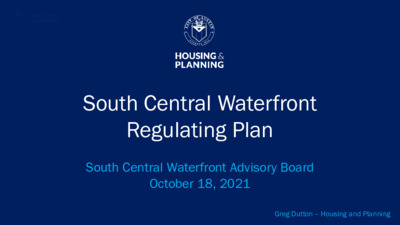Item 3.a.: South Central Waterfront Regulating Plan Overview and Status Update — original pdf
Backup

South Central Waterfront Regulating Plan South Central Waterfront Advisory Board October 18, 2021 Greg Dutton – Housing and Planning Content Overall Process Regulating Plan How will it work? What will it do? What will it not do? Physical framework focus What questions remain? Next Steps Overall Process Regulating Plan Creation Incorporation into LDC (Adoption) 3 Regulating Plan: how will it work? Mechanically similar to University Neighborhood Overlay (UNO) Developer decides to participate Site plan filed in compliance with regulating plan Process is administrative 4 Regulating Plan: how will it work? Developer Provides: • On-site affordable housing • Fee-in-lieu affordable housing • Parks, open space, trails, infrastructure improvements Developer Gets: • Increased entitlements 5 Regulating Plan: what will it do? Control physical buildout Lay out public benefits and developer incentives Include requirements for Affordable Housing provided by private developments that utilize bonus entitlements Streets, blocks, open space, streetscape, frontage, building placement, building height, land uses, parking and transportation, impervious cover 6 Regulating Plan: what will it not do? Does not mandate participation Does not speak to financing, funding sources, or public-private Does not allow wiggle room or negotiating Part of a larger toolbox - will not achieve the framework vision by partnerships itself 7 Regulating Plan: Physical framework focus $ Physical Framework Financial Framework City Leadership Green Streets, Pedestrian Connections & Open Space for a great & green public realm Value Capture & cost sharing, Strategic Capital Investments and Bonus Entitlements to fund public realm and 20% affordable housing Leverage City assets and establish agencies and rules to achieve Public-Private Partnerships to achieve community goals 8 Regulating Plan: what questions remain? Are there financial tools robust enough to fill financing gap? Are the public benefits and developer incentives properly balanced? Should all properties within the area be eligible? 9 Next Steps Financial toolbox feasibility Statesman PUD resolution Regulating plan revisions and adoption 20% Affordable Housing Gap Finance 1 0 Contact Information Greg Dutton 512-974-3509 greg.dutton@austintexas.gov 1 1